Use of Gene-Expression Profiling to Recommend Adjuvant Chemotherapy for Breast Cancer
One of the primary challenges in the treatment of patients with early-stage breast cancer is determining which patients will benefit from adjuvant chemotherapy. Traditionally, treatment decisions have been made based on a combination of tumor characteristics and patient and physician perspectives regarding risks and benefits. Recent technologic advances, including the development of gene-expression arrays, have led to the identification of molecular signatures that provide prognostic information in addition to the basic clinicopathologic features of individual tumors. While these new methods allow for more refined determination of prognosis for an individual patient, few data are available to support use of these new technologies in the clinic for treatment decision-making. At present, data from a single retrospective study are available to support the use of one assay, the 21-gene recurrence score, for decision-making regarding adjuvant chemotherapy. Large, multinational clinical trials are currently ongoing to evaluate the use of two of the multiparameter assays, although it will be many years before oncologists can apply the results of these trials in the clinic.
One of the primary challenges in the treatment of patients with early-stage breast cancer is determining which patients will benefit from adjuvant chemotherapy. Traditionally, treatment decisions have been made based on a combination of tumor characteristics and patient and physician perspectives regarding risks and benefits. Recent technologic advances, including the development of gene-expression arrays, have led to the identification of molecular signatures that provide prognostic information in addition to the basic clinicopathologic features of individual tumors. While these new methods allow for more refined determination of prognosis for an individual patient, few data are available to support use of these new technologies in the clinic for treatment decision-making. At present, data from a single retrospective study are available to support the use of one assay, the 21-gene recurrence score, for decision-making regarding adjuvant chemotherapy. Large, multinational clinical trials are currently ongoing to evaluate the use of two of the multiparameter assays, although it will be many years before oncologists can apply the results of these trials in the clinic.
A primary challenge for medical oncologists treating women with early-stage breast cancer is deciding which patients should receive adjuvant chemotherapy. It would be helpful to identify which patients either will not relapse at all or will relapse without adjuvant chemotherapy (prognosis) and which therapies are most likely to work against specific cancers (prediction), so that only patients who will obtain benefit are exposed to the inherent toxicities. Historically, this assessment of risk of distant metastatic disease has been based on clinicopathologic features of the tumor, such as lymph node involvement and histologic grade. More recently, the development of multiparameter assays has permitted more detailed evaluation of the biology-as opposed to the anatomy-of tumors. This review will discuss the development of these tools, and whether they are ready for use in the clinics to make individual treatment decisions regarding adjuvant chemotherapy.
Adjuvant Systemic Therapy
Breast cancer remains the most common malignancy in women in the United States. However, breast cancer–specific mortality has been decreasing, due in part to earlier detection of disease with screening mammography and to improved treatment of disease with adjuvant systemic therapies.[1,2] Surgery and radiation therapy are curative for the majority of patients, who obtain no additional benefit from adjuvant systemic therapy. Conversely, for those patients at high risk for recurrence, systemic therapy does not necessarily prevent development of distant metastases.
Unfortunately, no prognostic or predictive factor is 100% perfect for determining benefit from a given therapy for an individual patient. Because of this uncertainty, should all patients receive all available therapies? If a patient is willing to accept any toxicity for any benefit then perhaps she should be treated with everything. In reality, however, the majority of patients are willing to forgo some benefit in order to avoid some toxicity, so therapy must be carefully selected.
Patient Acceptance
By querying breast cancer patients who had previously received chemotherapy, several investigators have attempted to determine the smallest absolute chemotherapy benefit that patients are willing to accept, based on their prior treatment experiences.[3-5] For example, one study evaluated breast cancer survivors previously treated with CMF (cyclophosphamide, methotrexate, fluorouracil [5-FU]) for 6 months.[3] As expected, when asked if they would accept treatment with chemotherapy in a number of hypothetical scenarios, most patients stated that they would opt for therapy again when the gains were large (> 10% absolute benefit), and fewer were willing to do so as the odds of benefit decreased. However, more than 50% of patients said they would undergo chemotherapy for as little as a 3% to 5% absolute improvement in outcome, and nearly 50% stated that they would be willing to accept therapy for as little as a 1% absolute benefit.[3]
These results are remarkably similar to two other studies, suggesting that although these results may be confounded since subjects had survived their breast cancer, a large number of women seem to be willing to take chemotherapy for very small potential chances of benefit. Even so, a substantial proportion of patients would not accept therapy for an absolute benefit of less than 10%, and therefore it remains critically important to determine prognosis and prediction as accurately as possible.
Guidelines and Algorithms
Multiple methods are commonly used by clinicians to determine prognosis. Traditionally the key factors used to estimate the risk of distant metastatic disease include lymph node involvement, histologic grade, tumor size, and expression of hormone receptors (HR) and HER2 (erbB2). The TNM staging system, which combines tumor size (T), lymph node status (N), and presence or absence of distant metastasis (M), has been correlated with prognosis.[6,7]
In order to use these factors for clinical decision-making, numerous guidelines have been developed by agencies in both the United States and Europe. The National Comprehensive Cancer Network (NCCN) guidelines recommend adjuvant chemotherapy for patients with lymph node involvement, for those with HR-negative breast cancer and tumor size > 1 cm, and for those with HR- and HER2-positive disease and tumor size > 1 cm.[8] The NCCN recommends consideration of chemotherapy for patients with tumor size 0.6 to 1.0 cm regardless of HR status, and those with HR-positive and HER2-negative disease and tumor size > 1 cm.
The St. Gallen guidelines differ slightly from those of the NCCN. They recommend adjuvant chemotherapy for patients with HR-positive, high-risk disease or HR-negative, intermediate- or high-risk disease, and recommend consideration of chemotherapy for patients with HR-positive, intermediate-risk disease[9]. High-risk disease is defined as four or more nodes positive with any HER2 status, or one to three nodes positive and HER2 overexpressed. Low risk is considered age ≥ 35, tumor size ≤ 2 cm, grade 1, no angiolymphatic invasion, and HER2-negative.
For example, consider a 55-year-old woman with a 3-cm, grade 1, ER-positive, HER2-negative tumor with four positive lymph nodes. Using the standard prognostic factors outlined above, in the absence of systemic therapy she has an approximately 50% chance of recurrence over the succeeding 10 to 15 years after diagnosis. Using either the NCCN or St. Gallen guidelines, adjuvant chemotherapy followed by hormonal therapy would be recommended for this patient. Now suppose the patient's tumor was 1.5 cm with no lymph node involvement. In the absence of systemic therapy, her 10-year risk of recurrence is approximately 15%. In this situation, adjuvant chemotherapy should be considered in addition to hormonal therapy according to the NCCN guidelines, but only hormonal therapy should be offered according to the St. Gallen guidelines.
In an attempt to make it easier for physicians to apply the guidelines to individual patients, multiple computer-based algorithms and decision aides have been developed.[10,11] With Adjuvant! Online, the most widely used and highly validated program, the treating oncologist inputs information including patient age, comorbidities, tumor size, histologic grade, HR status, and number of positive nodes, and the computer program predicts the 10-year risk of relapse and mortality for the patient.[10] Based on the physician's choice of chemotherapy and/or endocrine therapy regimen, estimated benefit from each systemic therapy modality is given. The algorithm was validated in a large breast cancer registry, and performed well except in very young women.[12] In the example given above, depending on choice of chemotherapy, the estimated absolute benefit from chemotherapy in the first scenario is 6% to 12%, whereas in the second scenario it is only 2% to 4%.
While these guidelines and computer algorithms allow for individualized decision-making for adjuvant therapy based on the clinicopathologic characteristics of a patient's tumor, they are imperfect. The oncologist still lacks the ability to predict for an individual patient whether her disease will relapse, and whether she will obtain benefit from adjuvant chemotherapy. Therefore, newer methods of assessing breast cancer prognosis and need for systemic therapy are required.
Prognosis and Prediction
Taken together, the considerations above highlight the importance of prognostic and predictive factors. Prognostic factors reflect the metastatic potential and/or growth rate of the tumor, and are used to determine patient outcomes without consideration of treatment administered.[13] For example, ER expression is generally considered a favorable prognostic factor, whereas Ki67 is unfavorable. Conversely, predictive factors reflect the sensitivity or resistance of a tumor to a therapeutic agent, and therefore are used to predict which patients are likely to respond to a specific treatment.[14] ER expression is predictive for response to endocrine therapy, whereas HER2 overexpression is predictive for response to HER2-directed therapies, such as trastuzumab (Herceptin).
Indeed, a factor may be favorable for both prognosis and prediction (as in the ER example given above), or may be mixed. For example, HER2 is an unfavorable prognostic factor, but is a favorable predictive factor for response to HER2-directed therapies (Table 1). Until appropriate studies have been performed, however, it can be difficult to know how to use prognostic and predictive factors appropriately in the clinical setting. Prognostic and predictive properties based on currently available data for three common tumor markers are given in Table 1.
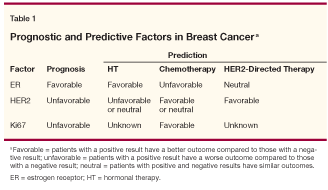
Multiparameter Assays
Traditional methods of tumor marker or prognostic factor analysis have involved evaluation of one factor at a time, and only occasionally were factors combined into models such as the TNM staging system described above. Recent advances in technology and bioinformatics have enabled simultaneous evaluation of hundreds or thousands of genes (genomics) or proteins (proteomics) in multiparameter assays.[15,16] Specific identifiable patterns of genes or proteins, termed molecular "signatures" or profiles, are associated with a given phenotype, such as prognosis.
One such approach is gene-expression profiling with DNA microarrays.[16] First, thousands of small DNA fragments (spots), each representing a single gene, are synthesized on a chip. RNA extracted from frozen breast cancer tumors is then hybridized to the spots. The amount of hybridization at each spot corresponds to the level of gene expression, which can be increased, decreased, or stable relative to a control. Those genes with up- or downregulated expression in the tumor are further evaluated with a computer algorithm using unstructured cluster analysis to identify gene expression patterns. Most DNA microarray experiments have required isolation of high-quality RNA from frozen tumor samples. More recently, investigators have also combined laser capture dissection of fixed tissue with T7-based linear amplification of RNA in order to generate enough RNA of sufficient quality to perform DNA microarray analyses.[17]
A different approach uses multiplex, quantitative real time reverse transcriptase polymerase chain reaction (RT-PCR) assays to evaluate expression of specific candidate genes from RNA isolated from fixed tumor tissue. Techniques have been developed to synthesize complementary DNA (cDNA) from fragmented RNA obtained from paraffin blocks using gene-specific priming.[18] Similarly, the T7-based amplified RNA has also been converted to cDNA for use in RT-PCR.[19] These new methods allow for use of RT-PCR to accurately measure expression of mRNA from fixed tissue. For analysis of these results, the expression levels of the evaluated genes are then incorporated into a computer algorithm.
Gene expression profiling using these methods is becoming more widespread as advances are made in the fields of technology and bioinformatics. Both the DNA microarray and RT-PCR methods are continuously being refined, with a short-term goal of improving the accuracy of breast cancer prognosis and a long-term goal of providing clinically beneficial information to patients.
Gene-Expression Arrays
One of the first demonstrations of the use of gene-expression profiling in breast cancer was by Perou et al, who used used cDNA microarrays to evaluate 65 tumor specimens from 42 individuals.[20] The tumors grouped into four intrinsic subtypes: luminal/epithelial ER-positive, normal-like, basal-like, and erbB2-positive. Further refinement of the hierarchical cluster analysis led to division of the luminal grouping into subtypes A and B, with corresponding different prognoses.[21]
Based on this preliminary, groundbreaking work, multiple investigators have developed multiparameter assays to identify numerous molecular signatures in breast tumors based on alterations in gene-expression levels (Tables 2 and 3).[18,21-41] However, the development of these signatures has occurred in a somewhat haphazard manner. As opposed to defining molecular profiles using rigorous scientific methods and a predetermined hypothesis, many were identified using a seemingly random selection of available tumor samples from patient cohorts with very heterogeneous characteristics, such as variable tumor stage, hormone receptor status, and treatment regimen.[42] In addition, some signatures have not yet been validated on a set of tumor samples completely independent from the training set used for development of the profile.
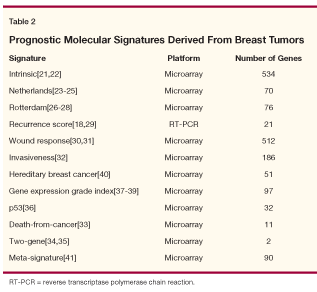
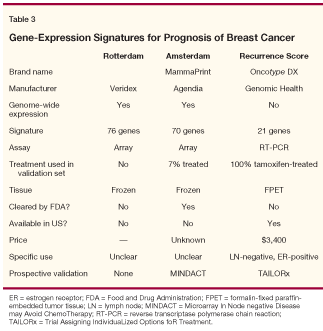
Despite these shortcomings, multiple signatures are now being evaluated as prognostic and predictive factors in breast cancer and introduced into clinical practice. The three most studied molecular signatures-two based on DNA microarrays and one established with RT-PCR-are described below.
• Netherlands 70-Gene Signature-This signature was developed at the Netherlands Cancer Institute based on analysis of fresh frozen tumors from 78 selected, mostly untreated lymph node–negative patients under age 55 with tumors less than 5 cm in size.[24] Using the Agilent platform, a 70-gene prognostic signature was developed by comparing gene-expression profiles from subjects who developed distant metastases within 5 years of diagnosis to profiles from those who remained disease-free.
The signature was then validated in a set of 295 tumors from patients with stage I and II breast cancer (age < 53, 51% lymph node–negative, 75% ER-positive).[23] A subset of patients had systemic treatment with chemotherapy and/or endocrine therapy, and 61 patients (21%) had been used in the previous training set. There was a clear separation of overall and distant metastasis-free survival between the good- and poor-risk groups, with 10-year distant metastasis-free survivals of 94.5% and 54.6%, respectively. Comparison of the signature with clinicopathologic classification of patients using the St. Gallen guidelines demonstrated that misclassification of patients can occur when only clinicopathologic criteria are taken into account, leading to both over- and undertreatment of patients.
A second validation was performed using 307 independent patients diagnosed with breast cancer between 1980 and 1998, and the signature was directly compared to standard clinicopathologic classification using Adjuvant! Online.[25] The patient cohort included untreated women under the age of 61 with lymph node–negative tumors less than 5 cm in size. The authors concluded that the 70-gene signature added independent prognostic information to the standard clinicopathologic factors. The relative hazard ratio was less than seen in the prior study described above, although the tumor characteristics of the study populations differed. In addition, as noted in the accompanying editorial, the authors failed to demonstrate that use of the molecular profile for patient care improved outcomes.[43]
Nonetheless, based on these data, the MammaPrint assay (Agendia BV, Amsterdam) was recently cleared for marketing by the US Food and Drug Administration (FDA) for assessment of risk of developing distant metastases in women under 61 years of age with lymph node–negative tumors less than 5 cm in size.
• Rotterdam Signature-A second molecular signature was developed in conjunction with Veridex LLC (San Diego) using a different gene-expression microarray platform, the Affymatrix U133a GeneChip.[26] This analysis was performed on fresh frozen tumors from a training set of 115 untreated patients of all ages without lymph node involvement, separated into ER-positive (80 patients) and ER-negative (35 patients) subgroups based on immunohistochemical analysis. The signature discriminated between patients at high- and low-risk of developing distant metastases, and was validated using an independent cohort of 171 patients. When compared to risk assessment using the St. Gallen criteria, adjuvant chemotherapy would have been recommended using either method for a similar number of women who developed metastatic disease by 5 years, whereas use of the molecular signature would have resulted in the recommendation of adjuvant chemotherapy for significantly fewer women who remained disease-free at 5 years (52% vs 90%).
A second validation was performed on 180 untreated patients with lymph node–negative breast cancer.[28] Analysis of this cohort using the Rotterdam signature resulted in 10-year metastasis-free survival rates of 94% and 65% for the good- and poor-profile groups, respectively. The signature was strongly prognostic for patients with ER-positive disease and for tumors ≤ 2 cm in size, and was independent of menstrual status. A third validation using 198 untreated patients (lymph node–negative, 32% ER-negative) revealed distant metastasis-free rates of 94% and 73% for the good- and poor-profile subgroups, respectively.[27] The signature was also shown to add prognostic information to that provided by Adjuvant! Online.
Both of these signatures separate patients into two prognostic groups-good and poor risk-by analyzing fresh frozen tumor tissue on DNA microarrays. These assays may be challenging to perform in the United States, where immediate fixation of tumor specimens is more common. Both molecular profiles have been validated on independent, retrospectively collected selections of tumor samples. Sample selection for the validation studies has led to restrictions on clinical use of the MammaPrint assay, which was only cleared by the FDA for use in women under the age of 61 with lymph node–negative tumors less than 5 cm in size.
More importantly, however, clinical utility has not yet been clearly demonstrated for either molecular signature. For example, the signatures have not been used to compare chemotherapy-treated vs untreated patients to demonstrate that poor-risk patients benefit from chemotherapy and/or that good-risk patients obtain no benefit from chemotherapy. In addition, neither signature has been evaluated prospectively.
Multiplex RT-PCR
A third multiplex molecular assay, Oncotype DX (Genomic Health, Inc, Redwood City, Calif), is based on real-time quantitative RT-PCR rather than DNA-expression profiling, and yields a recurrence score (RS) from 0 to 100. In initial studies, RT-PCR was used to determine expression of 250 candidate genes using RNA extracted from formalin-fixed, paraffin-embedded fixed tumor tissues. The samples used in the training set were from tamoxifen-treated subjects with ER-positive, lymph node–negative breast cancer enrolled in three previously conducted clinical trials, including the National Surgical Adjuvant Breast and Bowel Project (NSABP) B-20 trial.[18]
By correlating gene expression with clinical outcome, an algorithm was developed using a subset of 16 of the original 250 genes, as well as 5 housekeeping genes, to calculate a recurrence score, which correlated with risk of breast cancer recurrence (Figure 1). This algorithm was then validated in independent cohorts of tamoxifen-treated patients with ER-positive, node-negative breast cancer, including patients enrolled in the NSABP B-14 trial[18] and a cohort of patients treated in a community setting.[44]
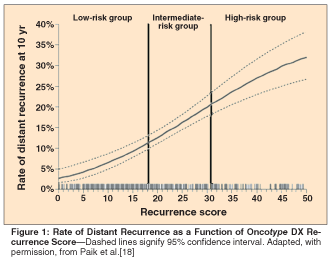
The Oncotype DX assay results in inclusion of about half of patients into the low recurrence risk group, about one-quarter into the intermediate group, and the remainder into the high recurrence risk group. Comparison with the Adjuvant! Online algorithm revealed only 48% agreement between the two assessments, and the two methods were shown to be independently prognostic.[45] This method has numerous advantages compared to the DNA microarray approach, especially lack of requirement for frozen tissue. Although the prognostic value of this assay has been evaluated using retrospectively obtained tumor samples derived from independent cohorts of patients, no prospective trial evaluating use of this assay in clinical practice has yet been completed.
Other DNA Microarray-Based Signatures
Numerous other molecular signatures have been identified to date, as listed in Table 2. For example, profiles have been developed based on specific aspects of tumor biology, such as p53 mutations (p53 profile) and tumor grade (gene-expression grade index).[36-38] Another signature focuses on the role of fibroblasts in wound healing (wound response).[30,31] While these signatures are of interest, their clinical utility remains to be elucidated.
Concordance Among
Gene-Expression Assays
Fan et al performed a comparison of five of the methods included in Table 2 (intrinsic subtypes, Netherlands signature, recurrence score, wound response, and two-gene ratio), using the clinically heterogeneous set of 295 tumor samples that was used for validation of the Amsterdam signature (described above).[46] Four of the methods tested demonstrated clear separation of patients into good- and poor-risk groups, demonstrating the potential for clinical benefit using these signatures. The performance of the fifth method was difficult to assess because of the design of the comparison study.[47]
This comparison study has significant limitations. A substantial portion of the sample set used for evaluation of the signatures in this comparison study had been used as the training set for initial derivation of the Netherlands, intrinsic subtype, and wound response profiles. In addition, the sample set contained an assortment of tumors from treated and untreated, lymph node–positive and –negative, and ER-positive and -negative patients. Importantly, the recurrence score and two-gene signatures were initially designed to evaluate only ER-positive, lymph node–negative, tamoxifen-treated patients.
Also, the authors did not personally perform the assays as originally described for each signature (using the various DNA microarray platforms or Oncotype DX assay), but rather, used previously obtained microarray data for evaluation of the signatures in this comparison. Therefore, although the Netherlands signature and the recurrence score appear to yield similar results in this comparison, it is difficult to draw firm conclusions given the significant limitations of the comparison study design.
Predictive Assays
Can any of these tools help guide decision-making about adjuvant chemotherapy, especially in patients who may be at low risk for recurrence and therefore not derive significant benefit from the treatment? A study of patients who underwent neoadjuvant chemotherapy revealed a positive correlation between high RS and pathologic complete remission (pCR), suggesting that patients with a high RS are more likely to benefit from chemotherapy.[48]
This possibility was further analyzed using a cohort of 651 patients from NSABP B-20, of whom 434 received chemotherapy with cyclophosphamide and 5-FU with or without methotrexate.[29] Patients with a high RS (RS > 31) showed a large benefit from chemotherapy, with an absolute increase in distant recurrence-free survival at 10 years of 27.6% ± 8.0%. Conversely, patients with a low RS (RS < 18) derived minimal benefit from chemotherapy, with a change in distant recurrence-free survival at 10 years of –1.1% ± 2.2%.
These data from retrospective samples suggest that patients with ER-positive, node-negative breast cancer with a high RS are likely to benefit from chemotherapy, whereas those with a low RS should not receive chemotherapy. The data must be interpreted with caution, however, because the samples used to evaluate Oncotype DX as a predictive marker were also included in the training set used for development of the assay. In addition, the data were derived from patients enrolled in previously conducted studies that utilized older-generation chemotherapy. Therefore, many questions remain unanswered. Are the results still valid when patients are treated with more modern chemotherapy and/or endocrine therapy regimens? How should patients with intermediate RS be treated?
Future Directions
While all of these gene-expression assays appear to yield additional prognostic information about an individual patient's breast cancer, there is only scant data to support their use for guiding treatment decision-making. To address these issues, a number of ongoing prospective clinical trials are aimed at determining how best to use these new tools in clinical practice.
• TAILORx-One study being conducted primarily in the United States is the Trial Assigning IndividuaLized Options for Treatment (TAILORx), which is prospectively evaluating treatment of patients with ER-positive, HER2-negative, lymph node–negative breast cancer whose tumors have intermediate recurrence scores on the Oncotype DX assay (Figure 2).[49] Tumor size must be between 1 and 5 cm, or between 0.5 and 1 cm if unfavorable histologic factors are also present. Patients with a low RS (≤ 10) will receive endocrine therapy, those with a high RS (> 25) will receive both chemotherapy and endocrine therapy, and those in between will be randomized to chemotherapy plus endocrine therapy vs endocrine therapy alone. The RS cutoff values were shifted downward because of the concern that patients at the upper end of the intermediate-risk group were likely to derive benefit from chemotherapy, and the investigators did not want to withhold chemotherapy from this cohort.
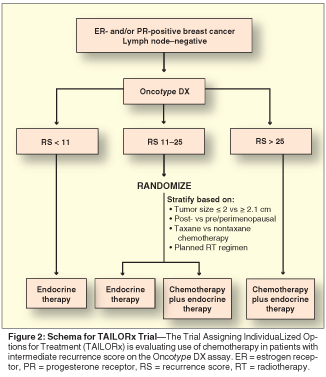
Follow-up data are also being collected about patients in the high-risk cohort who are being treated with both chemotherapy and hormone therapy. The results of this prospective trial should provide guidance for the management of patients whose tumors are at intermediate risk of recurrence, and may yield information about the benefit of modern chemotherapy regimens in this patient population.
• MINDACT-A separate prospective trial, Microarray In Node negative Disease may Avoid ChemoTherapy (MINDACT), is evaluating the use of MammaPrint for selection of patients to receive chemotherapy (Figure 3).[50] This trial, which is being primarily conducted in Europe, will enroll patients with T1, T2, or operable T3 breast cancer that is lymph node–negative. Prognosis will be assessed with both the 70-gene molecular signature (genomic) and with Adjuvant! Online (clinical).
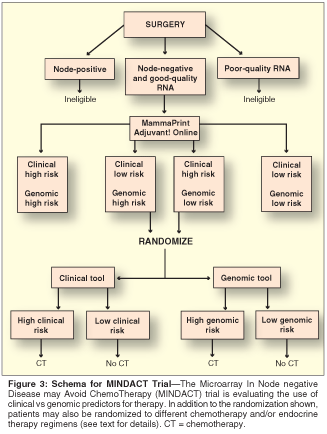
Patients with discordant results will be randomized to either clinical or genomic decision-making. Those randomized to the clinical arm will receive chemotherapy only if they are at high risk based on Adjuvant! Online. Those randomized to the genomic arm will receive chemotherapy only if they have a poor prognosis based on the 70-gene signature. In addition, those who receive chemotherapy may be randomized to either an anthracycline-based regimen or a docetaxel (Taxotere)/capecitabine (Xeloda) combination. Those eligible for endocrine therapy may be randomized to 7 years of letrozole (Femara) or to 2 years of tamoxifen followed by 5 years of letrozole.
This ambitious trial is designed to provide information about most of the issues described above, including whether clinicopathologic or genomic data should be the primary factor used for treatment decision-making, and for patients who are randomized to therapy, which adjuvant chemotherapy and/or endocrine therapy approaches are superior.
Conclusions
In summary, advances in technology have led to the introduction of multiple prognostic signatures for breast cancer. While the majority of these have been validated for determining prognosis, it remains to be seen how best to use these new tools in the clinical setting. Although the data supporting the prognostic and predictive value of Oncotype DX are based on retrospective patient samples, the assay is increasing in popularity in the clinical setting, and is currently the preferable platform in the United States because it is performed on fixed tissue specimens. However, many important clinical questions remain, which large multinational prospective clinical trials have only recently begun to address.
Disclosures:
Dr. Hayes is a consultant or advisory panel participant/lecturer for and/or has received an honorarium from StemCapture, American Biosciences, Abraxis, Cytogen Corp, AviaraDx, Precision Therapeutics, Inc, Monogram Bioscience, Siemens Medical Solutions Diagnostics, Pfizer, and Predictive Biosciences; and is the principle or co-investigator for sponsored clinical research for GlaxoSmithKline, Pfizer, Novartis, and the Wyeth-Ayerst Genetics Institute.
References:
1. Peto R, Boreham J, Clarke M, et al: UK and USA breast cancer deaths down 25% in year 2000 at ages 20-69 years. Lancet 355:1822, 2000.
2. Berry DA, Cronin KA, Plevritis SK, et al: Effect of screening and adjuvant therapy on mortality from breast cancer. N Engl J Med 353:1784-1792, 2005.
3. Coates AS, Simes RJ: Patient assessment of adjuvant treatment in operable breast cancer; in Williams CJ (ed): Introducing New Treatments for Cancer: Practical, Ethical, and Legal Problems, pp 447-458. New York, John Wiley & Sons Ltd, 1992.
4. Ravdin P, Siminoff I, Harvey J: Survey of breast cancer patients concerning their knowledge and expectations of adjuvant therapy. J Clin Oncol 16:515-521, 1998.
5. Lindley C, Vasa S, Sawyer T, et al: Quality of life and preferences for treatment following systemic adjuvant therapy for early stage breast cancer. J Clin Oncol 16:1380-1387, 1998.
6. Greene FL, Page DL, Fleming I, et al (eds): AJCC Cancer Staging Manual, 6th ed. New York, Springer-Verlag, 2002.
7. Woodward WA, Strom EA, Tucker SL, et al: Changes in the 2003 American Joint Committee on Cancer staging for breast cancer dramatically affect stage-specific survival. J Clin Oncol 21:3244-3248, 2003.
8. Carlson RW, Anderson BO, Burstein HJ, et al: Breast cancer. J Natl Compr Canc Netw 3:238-289, 2005.
9. Goldhirsch A, Glick JH, Gelber RD, et al: Meeting highlights: International expert consensus on the primary therapy of early breast cancer 2005. Ann Oncol 16:1569-1583, 2005.
10. Ravdin PM, Siminoff LA, Davis GJ, et al: Computer program to assist in making decisions about adjuvant therapy for women with early breast cancer. J Clin Oncol 19:980-991, 2001.
11. Whelan TJ, Loprinzi C: Physician/patient decision aids for adjuvant therapy. J Clin Oncol 23:1627-1630, 2005.
12. Olivotto IA, Bajdik CD, Ravdin PM, et al: Population-based validation of the prognostic model Adjuvant! for early breast cancer. J Clin Oncol 23:2716-2725, 2005.
13. McGuire WL, Clark GM: Prognostic factors and treatment decisions in axillary-node-negative breast cancer. N Engl J Med 326:1756-1761, 1992.
14. Gasparini G, Pozza F, Harris AL: Evaluating the potential usefulness of new prognostic and predictive indicators in node-negative breast cancer patients. J Natl Cancer Inst 85:1206-1219, 1993.
15. Patterson SD, Aebersold RH: Proteomics: The first decade and beyond. Nature Genetics 33(suppl):311-323, 2003.
16. Quackenbush J: Microarray analysis and tumor classification. N Engl J Med 354:2463-2472, 2006.
17. Fuller AP, Palmer-Toy D, Erlander MG, et al: Laser capture microdissection and advanced molecular analysis of human breast cancer. J Mammary Gland Biol Neoplasia 8:335-345, 2003.
18. Paik S, Shak S, Tang G, et al: A multigene assay to predict recurrence of tamoxifen-treated, node-negative breast cancer. N Engl J Med 351:2817-2826, 2004.
19. Ma XJ, Patel R, Wang X, et al: Molecular classification of human cancers using a 92-gene real-time quantitative polymerase chain reaction assay. Arch Pathol Lab Med 130:465-473, 2006.
20. Perou CM, Sorlie T, Eisen MB, et al: Molecular portraits of human breast tumours. Nature 406:747-752, 2000.
21. Sorlie T, Perou CM, Tibshirani R, et al: Gene expression patterns of breast carcinomas distinguish tumor subclasses with clinical implications. Proc Natl Acad Sci USA 98:10869-10874, 2001.
22. Sorlie T, Tibshirani R, Parker J, et al: Repeated observation of breast tumor subtypes in independent gene expression data sets. Proc Natl Acad Sci USA 100:8418-8423, 2003.
23. van de Vijver MJ, He YD, van't Veer LJ, et al: A gene-expression signature as a predictor of survival in breast cancer. N Engl J Med 347:1999-2009, 2002.
24. van 't Veer LJ, Dai H, van de Vijver MJ, et al: Gene expression profiling predicts clinical outcome of breast cancer. Nature 415:530-536, 2002.
25. Buyse M, Loi S, van't Veer L, et al: Validation and clinical utility of a 70-gene prognostic signature for women with node-negative breast cancer. J Natl Cancer Inst 98:1183-1192, 2006.
26. Wang Y, Klijn JG, Zhang Y, et al: Gene-expression profiles to predict distant metastasis of lymph-node-negative primary breast cancer. Lancet 365:671-679, 2005.
27. Desmedt C, Piette F, Loi S, et al: Strong time dependence of the 76-gene prognostic signature for node-negative breast cancer patients in the transbig multicenter independent validation series. Clin Cancer Res 13:3207-3214, 2007.
28. Foekens JA, Atkins D, Zhang Y, et al: Multicenter validation of a gene expression-based prognostic signature in lymph node-negative primary breast cancer. J Clin Oncol 24:1665-1671, 2006.
29. Paik S, Tang G, Shak S, et al: Gene expression and benefit of chemotherapy in women with node-negative, estrogen receptor-positive breast cancer. J Clin Oncol 24:3726-3734, 2006.
30. Chang HY, Sneddon JB, Alizadeh AA, et al: Gene expression signature of fibroblast serum response predicts human cancer progression: Similarities between tumors and wounds. PLoS Biology 2:E7, 2004.
31. Chang HY, Nuyten DS, Sneddon JB, et al: Robustness, scalability, and integration of a wound-response gene expression signature in predicting breast cancer survival. Proc Natl Acad Sci USA 102:3738-3743, 2005.
32. Liu R, Wang X, Chen GY, et al: The prognostic role of a gene signature from tumorigenic breast-cancer cells. N Engl J Med 356:217-226, 2007.
33. Glinsky GV, Berezovska O, Glinskii AB: Microarray analysis identifies a death-from-cancer signature predicting therapy failure in patients with multiple types of cancer. J Clin Invest 115:1503-1521, 2005.
34. Ma XJ, Wang Z, Ryan PD, et al: A two-gene expression ratio predicts clinical outcome in breast cancer patients treated with tamoxifen. Cancer Cell 5:607-616, 2004.
35. Goetz MP, Suman VJ, Ingle JN, et al: A two-gene expression ratio of homeobox 13 and interleukin-17b receptor for prediction of recurrence and survival in women receiving adjuvant tamoxifen. Clin Cancer Res 12:2080-2087, 2006.
36. Miller LD, Smeds J, George J, et al: An expression signature for p53 status in human breast cancer predicts mutation status, transcriptional effects, and patient survival. Proc Natl Acad Sci USA 102:13550-13555, 2005.
37. Sotiriou C, Wirapati P, Loi S, et al: Comprehensive analysis integrating both clinicopathological and gene expression data in more than 1,500 samples: Proliferation captured by gene expression grade index appears to be the strongest prognostic factor in breast cancer. J Clin Oncol 24:abst 507, 2006.
38. Loi S, Haibe-Kains B, Desmedt C, et al: Definition of clinically distinct molecular subtypes in estrogen receptor-positive breast carcinomas through genomic grade. J Clin Oncol 25:1239-1246, 2007.
39. Sotiriou C, Wirapati P, Loi S, et al: Gene expression profiling in breast cancer: Understanding the molecular basis of histologic grade to improve prognosis. J Natl Cancer Inst 98:262-272, 2006.
40. Hedenfalk I, Duggan D, Chen Y, et al: Gene-expression profiles in hereditary breast cancer. N Engl J Med 344:539-548, 2001.
41. Shen R, Ghosh D, Chinnaiyan AM: Prognostic meta-signature of breast cancer developed by two-stage mixture modeling of microarray data. BMC Genomics 5:94, 2004.
42. Henry NL, Hayes DF: Uses and abuses of tumor markers in the diagnosis, monitoring, and treatment of primary and metastatic breast cancer. Oncologist 11:541-552, 2006.
43. Simon R: Development and evaluation of therapeutically relevant predictive classifiers using gene expression profiling. J Natl Cancer Inst 98:1169-1171, 2006.
44. Habel LA, Shak S, Jacobs MK, et al: A population-based study of tumor gene expression and risk of breast cancer death among lymph node-negative patients. Breast Cancer Res 8:R25, 2006.
45. Paik S: Development and clinical utility of a 21-gene recurrence score prognostic assay in patients with early breast cancer treated with tamoxifen. Oncologist 12:631-635, 2007.
46. Fan C, Oh DS, Wessels L, et al: Concordance among gene-expression-based predictors for breast cancer. N Engl J Med 355:560-569, 2006.
47. Goetz MP, Ingle JN, Couch FJ, et al: Gene-expression-based predictors for breast cancer. N Engl J Med 356:752-753, 2007.
48. Gianni L, Zambetti M, Clark K, et al: Gene expression profiles in paraffin-embedded core biopsy tissue predict response to chemotherapy in women with locally advanced breast cancer. J Clin Oncol 23:7265-7277, 2005.
49. Sparano JA: TAILORx: Trial assigning individualized options for treatment. Clin Breast Cancer 7:347-350, 2006.
50. Bogaerts J, Cardoso F, Buyse M, et al: Gene signature evaluation as a prognostic tool: Challenges in the design of the MINDACT trial. Nature Clin Pract Oncol 3:540-551, 2006.